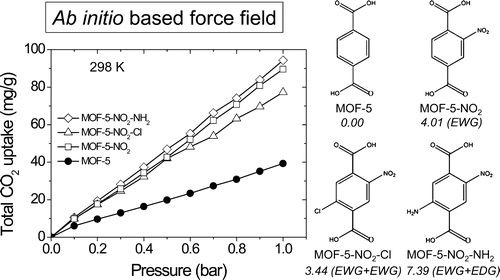Accurate Ab Initio-Based Force Field for Predictive CO2 Uptake Simulations in MOFs and ZIFs: Development and Applications for MTV-MOFs
슈퍼관리자
2021-05-21
Accurate Ab Initio-Based Force Field for Predictive CO2 Uptake Simulations in MOFs and ZIFs: Development and Applications for MTV-MOFs
-
Authors :
S. S. Han, D. Kim, D. H. Jung, S. Cho, S. -H. Choi, and Y. Jung
-
Journal :
Journal of Physical Chemistry C
-
Vol :
116
-
Page :
20254-20261
-
Year :
2012

Abstract
For a reliable prediction of CO2 loading in metal–organic (MOFs) and zeolitic-imidazolate frameworks (ZIFs) by molecular simulation, accurate description of the van der Waals (vdW) and Coulomb interactions is undoubtedly the most critical component. However, there have been some strong recent indications that the use of generic force fields (FFs) widely used in most current CO2/MOF simulations that were not particularly parametrized for CO2/MOF and ZIF systems could lead to serious discrepancies compared to experimental results. Here, we develop accurate vdW FFs for CO2 uptake simulations in MOFs and ZIFs using high-level ab initio calculations, and validate the method by comparing the simulated and experimental CO2 uptakes for various known MOFs and ZIFs. The agreements between simulations and experiments are shown to be excellent for several known MOFs and ZIFs, although the FF parameters are not specifically fitted to those particular systems, showing the potential transferability of the FF. Atomic charges of the adsorbents are computed via the rapid charge equilibration method. Using these highly accurate FFs, we reveal the origin of the enhanced CO2 uptake in recently reported MOFs having multivariate functional groups (MTV-MOFs). We find that the capacity enhancement in MTV-MOFs arises from an increase in both vdW (due to tighter geometry) and electrostatic (due to increased dipole moment) interactions between CO2 and MTV-MOF. We further predict that MOF-5-NO2 can have an even higher CO2 uptake than these MTV-MOFs due to a larger local dipole moment of the NO2-functionalized linker than those found in the reported MTV-MOFs. As a further designing of the high capacity material, we then introduced both electron-donating and -withdrawing functional groups simultaneously in the same organic linker to increase the local dipole moment of the linker significantly. The resulting CO2 uptake indeed increases substantially due to the favorable electrostatic interactions that can be tested experimentally.















